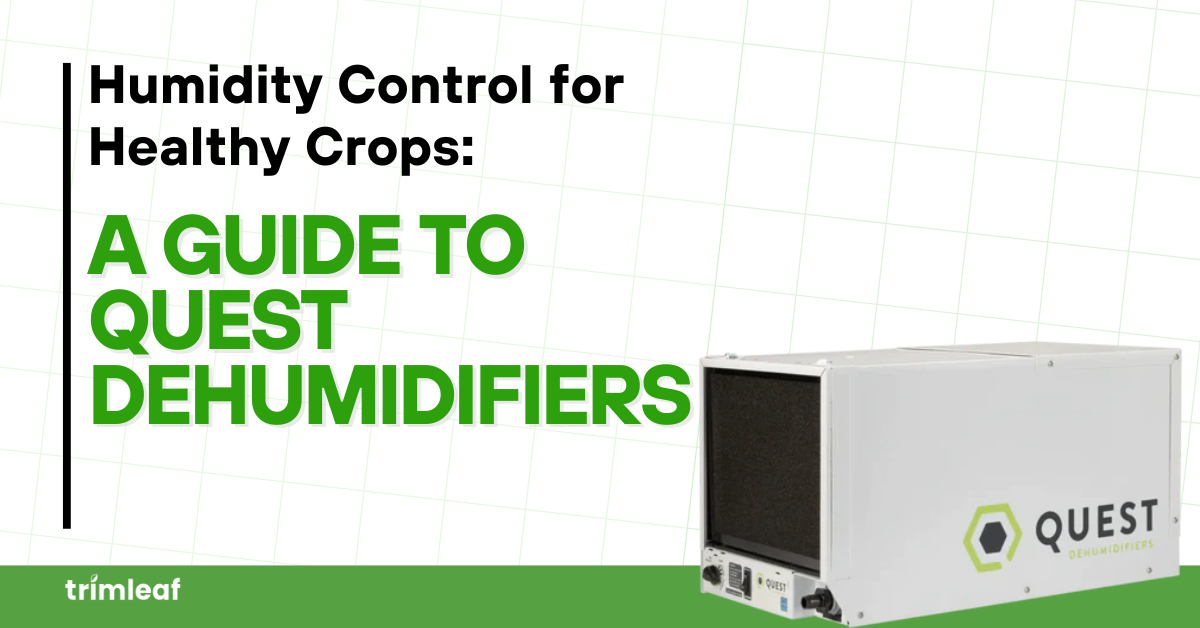
Humidity plays a critical role in plant growth and crop health. Excessive humidity disrupts the growth cycle and becomes a breeding ground for issues like powdery mildew and bud rot. Controlling humidity levels becomes pivotal for mitigating these challenges and ensuring a thriving, disease-free crop. To combat the adverse effects of humidity, indoor farmers invest in dehumidifiers to maintain optimal moisture levels needed for plant development. If you're an indoor grower struggling with humidity, check out the dehumidifiers made by Quest Climate.
About Quest Climate
Based in Madison, Wisconsin, Quest Climate is one of the front-runners in indoor humidity management. With a steadfast commitment to energy efficiency, durability, and flexibility, Quest's dehumidifiers seek to set the gold standard in growing inside controlled environments.
Quest's product line focuses on dehumidification and air moving. It notes that its products aren't one-trick ponies, as they can also be used for other industries, such as logistics, laboratories, food and beverage, and just about any other industry that could use controlled humidity and airflow.
Quest Dehumidifiers
Quest currently has 11 dehumidifier models in the market today. Each dehumidifier differs based on how much water it can pull out daily.
One thing to note about their dehumidifiers is their flexibility: most dehumidifiers can be installed freestanding or suspended above the plant canopy. All Quest Dehumidifiers feature a MERV filtration system. This system filters contaminants from being cycled back into the environment of your grow room.
Another feature worth noting with the Quest Dehumidifiers is the auto-restart feature that keeps you on track in case of a power interruption. They adhere to the highest safety standards, being UL-rated and ETL-listed. And for your convenience, each dehumidifier comes with a five-year warranty.
At the heart of Quest Climate's dehumidification efficiency is the Multi-Coil Refrigeration Recovery (M-CoRR). This patented technology is the secret to Quest’s dehumidification efficiency. M-CoRR uses a simple yet ingenious design: recycling.
Unlike traditional refrigerant dehumidifiers that rely on a single refrigerant-filled evaporator coil, M-CoRR takes the process to new heights with three distinct coils: the pre-evaporator, evaporator, and recovery coil. The Pre-Evaporator Coil initiates the cooling process, preparing the air, while the Evaporator Coil takes the cooling further, extracting water from the air. The Recovery Coil captures energy from pre-cooling the air, recycling it back into the evaporator for reuse.
Because of this design, Quest’s Dehumidifiers that use M-CoRR technology deliver better energy efficiency while extracting 30% more water from the air. The multiple-coil design also ensures optimal performance, even in cooler temperatures and dew points, giving you tighter control over the indoor environment.
At the same time, M-CoRR technology ensures less heat output, equating to less stress for your HVAC system. It’s also because of this efficiency that Quest Dehumidifiers are smaller than their market counterparts. It’s also because of its heat reduction that Quest Dehumidifiers are compliant with Title 24 Energy Regulations.
M-CoRR technology was initially included in higher-end dehumidifiers, but the good news is that they are now included in newer models.
Choosing the Right Dehumidifier: How many pints per day do you need?
Choosing a suitable dehumidifier capacity is a critical choice you need to do. If you choose an inadequate capacity, you can lose much to mildew and molds that can harm your crops.
To get the right dehumidifier, you need to understand three factors that affect the humidity in the grow room: size, placement, and airflow. Pulling out the same amount of water you bring in would be best. If you use around 25 gallons daily, that's about 160 pints of water you must pull out.
But it doesn't end there. You must also factor in other things, such as air conditioning, which mitigates excess humidity. But air conditioners are designed for cooling and not dehumidification; that's another thing to consider, as air conditioners are often not used at night unless temperatures are scorching.
Humidity can be a hit or miss in this instance. But the nice thing is that many dehumidifiers have built-in hygrometers that allow you to track the current humidity levels so that they can adjust accordingly.
That considered, you need to note your dehumidifier's capacity.
To help you choose, consider the water quantity naturally introduced and use that number as a basis. As dehumidifiers have built-in hygrometers, it's best to go for a dehumidifier that exceeds the water raised daily. Exceeding a little is okay, as hygrometers can help regulate the environment.
But don't work under capacity, as this can compromise your harvests. Go for an excess and control them with a hygrometer. Likewise, running several dehumidifiers that meet the required capacity and are evenly distributed is better than having only one, which can compromise your harvests when it breaks down.
Quest Dehumidifer for Small Rooms (Up to 500 square feet)
The nice thing about Quest is that they have dehumidifiers made for different room sizes. You will surely find a dehumidifier that works based on the room size and plant quantity.
For smaller spaces, the entry-level Quest 70 is an excellent choice. This dehumidifier removes up to 70 pints of moisture daily while consuming less power. The Quest 70 also has a 50-Hz version for the international market.
Up a notch is the Quest 100, one of the newer dehumidifiers from the brand. Since this is a newer model, this dehumidifier features M-CoRR technology, giving it a 100 pints per day capacity.
Another notable dehumidifier in the line-up is the Quest CDG 174. This dehumidifier was designed to move around your indoor space to supplement your existing dehumidifiers when you need a boost in dehumidifying capacity or without any invasive installation processes. With the wheels installed, you can move the CDG 174 anywhere required.
Medium-sized Dehumidifiers (500 - 1000 square feet)
First in this category is the Dual 105 Overhead, which has a 105-pint daily capacity and is designed for overhead installation. Following this is the Dual 110 Overhead with a slightly larger capacity at 110 pints and overhead installation design.
The Dual 150 Overhead is a good option for a bigger capacity with its 150 pints capacity. Following it is the Dual 155 Overhead with its 55 pints daily capacity, and the Dual 165 Overhead has a 165 pints daily capacity. Last in this category is the Dual 205 Overhead with a 205 pints daily capacity.
For those needing a dehumidifier in the middle tier, the Quest 225 is a good option to consider. It has a 225-pint capacity and also features M-CoRR technology. Climbing up a notch, the Quest 335 is worth looking into. It has a 350 pints daily capacity, and like the Quest 225, it also has M-CoRR.
Last on the list is the Quest 506, which has a 506 pints daily capacity and also features M-CoRR. This dehumidifier has an international version, which has the same features.
Large-scale Dehumidifiers (1000+ square feet)
The Quest line-up won’t be complete without its industrial-grade solutions. The flagship model, the Quest 876, features the patented M-CoRR technology and a whopping 876 pints daily capacity. At a slightly smaller capacity is the Quest 746, which has the same features as the 876 but has a 746 pints daily capacity.
Maintaining your Quest Dehumidifiers
The nice thing about Quest Dehumidifiers is its maintenance. For one, the impeller fan has been oiled to ensure years of use, and does not need oiling on your part. On the other hand, the air filter can be easily replaced and only needs a check once every six months. Replacing the filter when severely dirty is crucial as this affects the efficiency of the dehumidifiers.
How does Quest compare with the competition?
The closest competition of Quest in the market now is Anden. Both companies cater to similar audiences with dehumidifiers that offer efficiency. There is no doubt that both brands offer high water collection rates. However, the differences lie in the tiny details.
For one, Anden’s flagship dehumidifier, the A710V3, offers a water collection rate of 710 pints per day, a far cry from Quest’s 876 pints. Even going down a notch in Quest’s product line, the Quest 746 still beats Anden’s 710 pints. But perhaps the biggest difference between the two brands is certification. Quest holds Title 24 compliance, which certifies it as an energy-efficient brand based on the State of California’s energy standards.
The pursuit of a controlled environment for indoor growing lies in many factors, and humidity is a critical aspect you need to pay attention to. If you want to create the ideal climate with an optimized humidity level, the Quest dehumidifiers are what you need. They're versatile in installation and adhere to safety standards, including UL-rated and ETL-listed. The five-year warranty that each dehumidifier offers gives you peace of mind. That said, a Quest Dehumidifier is a good investment for your grow room or any room where you need a controlled environment.







